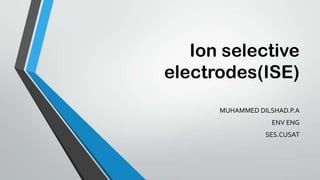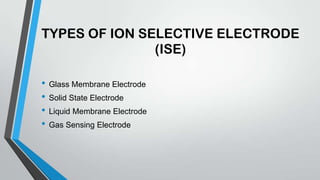Ion selective electrodes(ise)
- 1. Ion selective electrodes(ISE) MUHAMMED DILSHAD.P.A ENV ENG SES.CUSAT
- 2. Ion selective electrodes(ISE) ŌĆó - Also known as indicator electrodes ŌĆó - Respond directly to the analyte ŌĆó - Used for direct potentiometric measurements ŌĆó - Selectively binds and measures the activity of one ion (no redox chemistry) Examples ŌĆó pH electrode ŌĆó Calcium (Ca2+) electrode ŌĆó Chloride (Cl-) electrode
- 3. ŌĆó An ion-selective electrode (ISE), also known as a specific ion electrode (SIE), is a transducer (or sensor) that converts the activity of a specific ion dissolved in a solution into an electrical potential, which can be measured by a voltmeter or pH meter. ŌĆó An ideal I.S.E. consists of a thin membrane across which only the intended ion can be transported. ŌĆó The transport of ions from a high conc. to a low one through a selective binding with some sites within the membrane creates a potential difference.
- 5. ŌĆó
- 6. ŌĆó Ion Selective Electrodes (including the most common pH electrode) work on the basic principal of the galvanic cell .By measuring the electric potential generated across a membrane by "selected" ions, and comparing it to a reference electrode, a net charge is determined. The strength of this charge is directly proportional to the concentration of the selected ion. The basic formula is given for the galvanic cell: ŌĆó Ecell = EISE - ERef
- 7. TYPES OF ION SELECTIVE ELECTRODE (ISE) ŌĆó Glass Membrane Electrode ŌĆó Solid State Electrode ŌĆó Liquid Membrane Electrode ŌĆó Gas Sensing Electrode
- 8. GLASS MEMBRANE ELECTRODE ŌĆó Glass electrode are responsive to univalent cations ( H+ , Na+) ŌĆó The selectivity for this cation by varying the composition of a thin ion sensitive glass membrane. ŌĆó Example: pH electrode - used for pH measurement - used as a transducer in various gas and biocatalytic sensor, involving proton generating or consuming reaction.
- 9. ŌĆó Glass membrane manufactured from SiO2 with negatively charged oxygen atom. ŌĆó Inside the glass bulb, a dilute HCl solution and silver wire coated with a layer of silver chloride. ŌĆó The electrode is immersed in the solution and pH is measured.
- 10. SOLID STATE ELECTRODE ŌĆó Solid state electrode are selective primarily to anions. ŌĆó It may be a homogenous membrane electrode or heterogeneous membrane electrode. ŌĆó Homogenous membrane electrode: ion-selective electrodes in which the membrane is a crystalline material (AgI/Ag2S).
- 11. ŌĆó Solid state electrode are selective primarily to anions. ŌĆó It may be a homogenous membrane electrode or heterogeneous membrane electrode. ŌĆó Homogenous membrane electrode: ion-selective electrodes in which the membrane is a crystalline material (AgI/Ag2S).
- 12. LIQUID MEMBRANE ELECTRODE ŌĆó Liquid membrane is a type of ISE based on water-immiscible liquid substances produced in a polymeric membrane used for direct potentiometric measurement. ŌĆó Used for direct measurement of several polyvalent cations (Ca ion) as well as a certain anions.
- 13. ŌĆó The polymeric membrane made of PVC to separate the test solution from its inner compartment. ŌĆó Contains standard solution of the target ion. ŌĆó The filling solution contains a chloride salt for establishing the potential of the internal Ag/AgCl wire electrode.
- 14. GAS SENSING ELECTRODE ŌĆó Available for the measurement of ammonia, carbon dioxide and nitrogen oxide. ŌĆó This type of electrode consist of permeable membrane and an internal buffer solution. ŌĆó The pH of the buffer changes as the gas react with it.
- 15. ŌĆó The change is detected by a combination pH sensor within the housing. ŌĆó This type of electrode does not require an external reference electrode.
- 16. Advantages of Ion Selective Electrode (ISE) Technique ŌĆó When compared to many other analytical techniques, Ion-Selective Electrodes are relatively inexpensive and simple to use and have an extremely wide range of applications and wide concentration range. ŌĆó Under the most favorable conditions, when measuring ions in relatively dilute aqueous solutions and where interfering ions are not a problem, they can be used very rapidly and easily. ŌĆó They are particularly useful in applications where only an order of magnitude concentration is required, or it is only necessary to know that a particular ion is below a certain concentration level.
- 17. ŌĆó They are invaluable for the continuous monitoring of changes in concentration for example in potentiometric titrations or monitoring the uptake of nutrients, or the consumption of reagents. ŌĆó They are particularly useful in biological/medical applications because they measure the activity of the ion directly, rather than the concentration. ŌĆó ISEs are one of the few techniques which can measure both positive and negative ions. ŌĆó They are unaffected by sample colour or turbidity. ŌĆó ISEs can be used in aqueous solutions over a wide temperature range. Crystal membranes can operate in the range 0 C to 80 C and plastic membranes from 0 C to 50 C.
- 18. ’āśNon-destructive: no consumption of analyte. ’āśNon-contaminating. ’āśShort response time: in sec. or min. useful in industrial applications
- 19. LIMITATION ŌĆó Precision is rarely better than 1%. ŌĆó Electrodes can be fouled by proteins or other organic solutes. ŌĆó Interference by other ions. ŌĆó Electrodes are fragile and have limited shelf life. ŌĆó Electrodes respond to the activity of uncomplexed ion. So ligands must be absent.
- 20. Empirical Calibration Plot Potential (mV) Slope = 59/zi mV zi = charge of ion Called Nernstian slope - Used to determine the unknown concentration of analytes - Departure from linearity is observed at low concentrations
- 21. APPLICATION ŌĆó Ion-selective electrodes are used in a wide variety of applications for determining the concentrations of various ions in aqueous solutions.The following is a list of some of the main areas in which ISEs have been used. ŌĆó Pollution Monitoring: CN, F, S, Cl, NO3 etc., in effluents, and natural waters. ŌĆó Agriculture: NO3, Cl, NH4, K, Ca, I, CN in soils, plant material, fertilisers and feedstuffs. ŌĆó Food Processing: NO3, NO2 in meat preservatives. ŌĆó Salt content of meat, fish, dairy products, fruit juices, brewing solutions. ŌĆó F in drinking water and other drinks.
- 22. ŌĆó K in fruit juices and wine making. ŌĆó Corrosive effect of NO3 in canned foods. ŌĆó Detergent Manufacture:Ca, Ba, F for studying effects on water quality. ŌĆó Paper Manufacture: S andCl in pulping and recovery-cycle liquors. ŌĆó Explosives: F, Cl, NO3 in explosive materials and combustion products. ŌĆó Biomedical Laboratories: Ca, K, Cl in body fluids (blood, plasma, serum, sweat). ŌĆó F in skeletal and dental studies. ŌĆó Education and Research:Wide range of applications. ŌĆó Ca in dairy products and beer.
- 23. Determination of Fluoride Ion ŌĆó In the lanthanum fluoride electrode, the sensing element is a crystal of lanthanum fluoride LaF3, doped with europium fluoride EuF2 to create lattice vacancies. Such a crystal is an ionic conductor by virtue of the mobility of fluoride ions which jump between lattice vacancies. ŌĆó An electrochemical cell may be constructed using such a crystal as a membrane separating two fluoride solutions.This cell acts as a concentration cell with transference where the fluoride transport number is 1. As transference of charge through the crystal is almost exclusively due to fluoride, the electrode is highly specific to fluoride
- 24. ŌĆó The only ion which significantly interferes is hydroxide (OH-). Generally such "alkaline error" can be avoided by buffering the sample to a pH below 7 ŌĆó The cell diagram of a typical experimental arrangement is: ŌĆó Cu' | Ag,AgCl | KCl || solution | LaF3 | KF,KCl | AgCl,Ag | Cu ŌĆó where: ŌĆó Cu' | Ag, AgCl | KCl is an external reference electrode ŌĆó KF,KCl/AgCl,Ag/Cu is an internal reference inside the fluoride selective electrode
- 25. REFERENCE 1.Environmental chemical analysis ŌĆōlain L Marr, Malcolm s cresser 2.Instrumental analysis ŌĆōskoog,heller,crouch,2007 3.Standard methods-21st edition 2005 4.www,doiserbia.b.rs/img/doi/0352-5139/2013/0352-5139-1300098r.pdf

























